Urban Planning: 30 Years Projected Housing Plan
VerifiedAdded on 2023/03/30
|10
|2446
|356
AI Summary
This article discusses the 30-year projected housing plan for South Australia, including the increase in demand for housing and the adopted policies and strategies for implementation. It also compares the plan with Sydney's planning strategy.
Contribute Materials
Your contribution can guide someone’s learning journey. Share your
documents today.
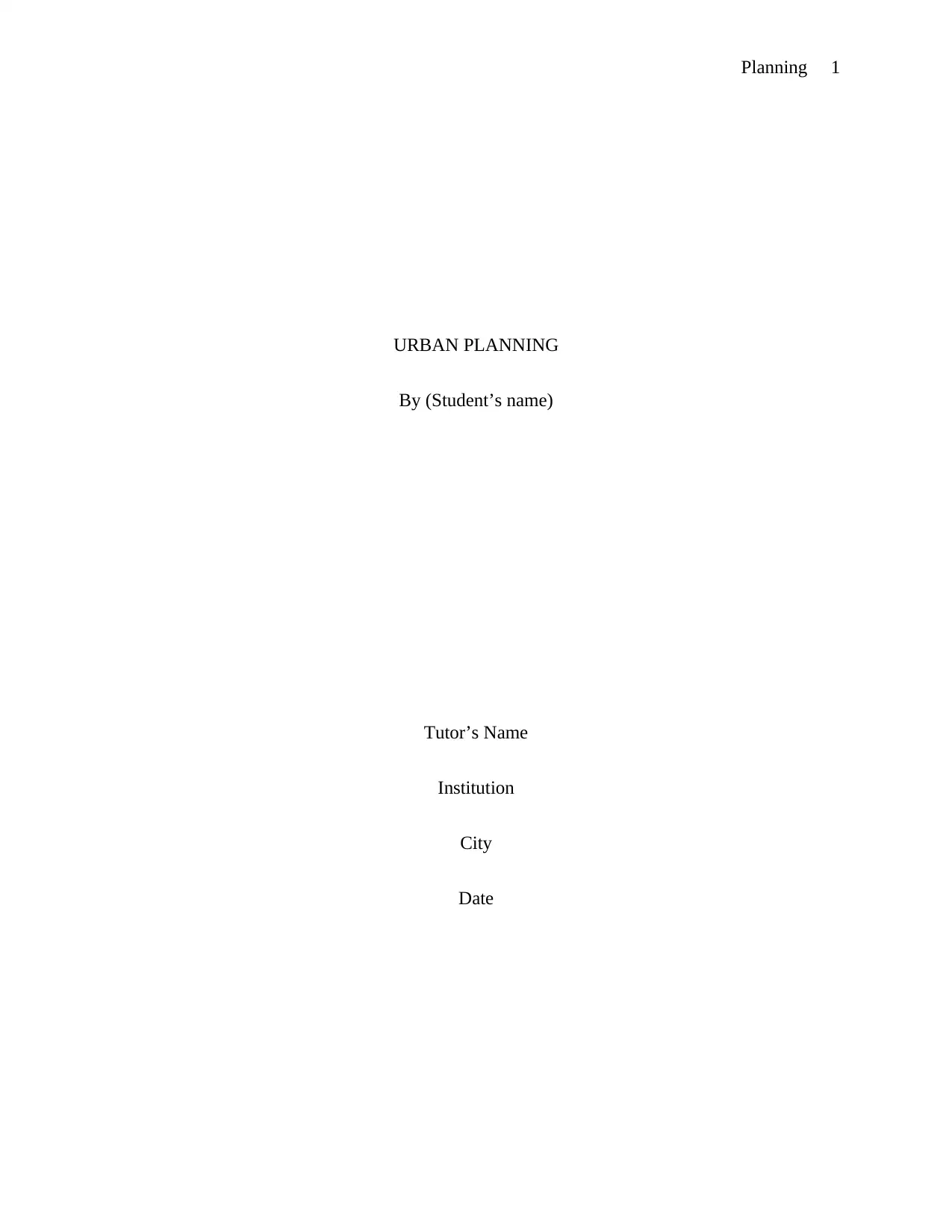
Planning 1
URBAN PLANNING
By (Student’s name)
Tutor’s Name
Institution
City
Date
URBAN PLANNING
By (Student’s name)
Tutor’s Name
Institution
City
Date
Secure Best Marks with AI Grader
Need help grading? Try our AI Grader for instant feedback on your assignments.
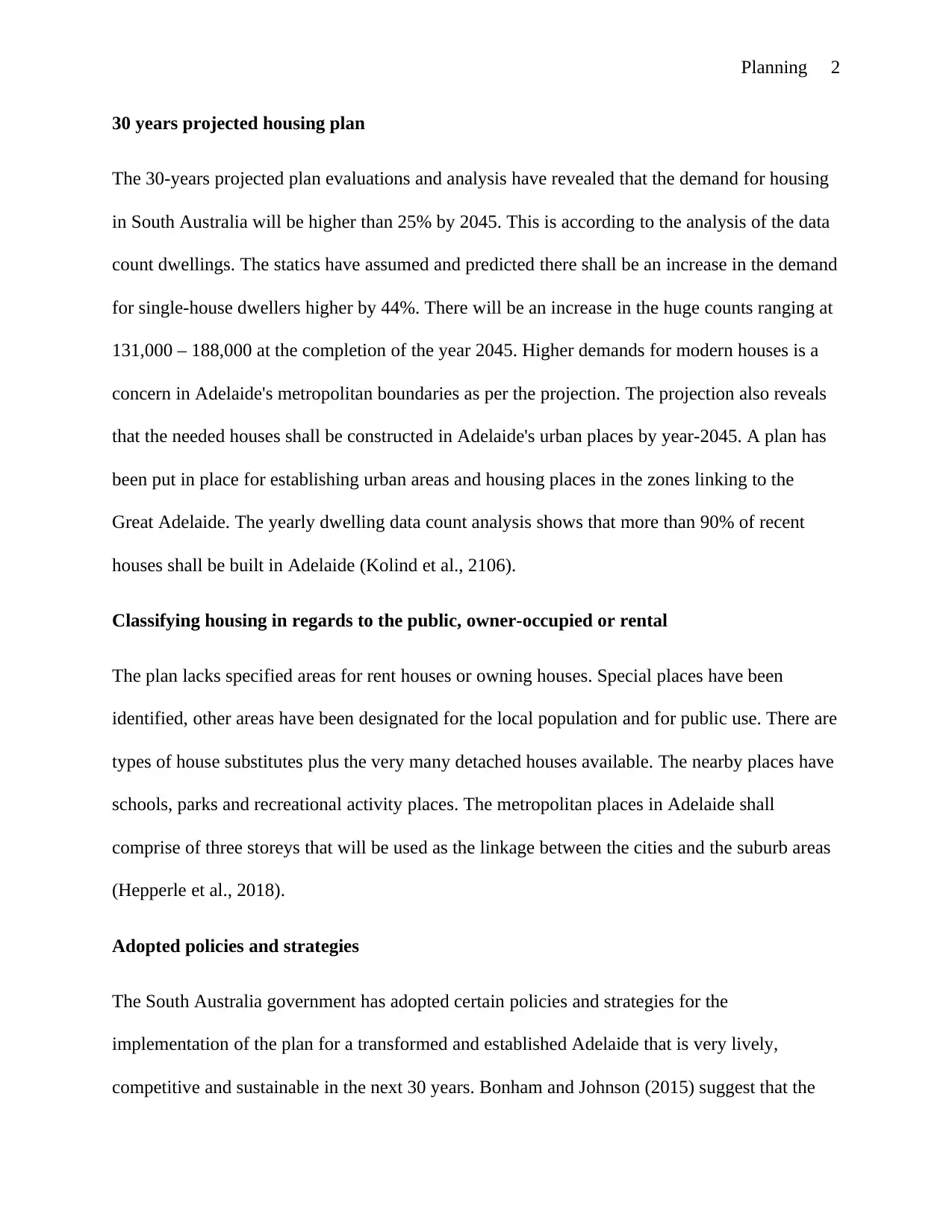
Planning 2
30 years projected housing plan
The 30-years projected plan evaluations and analysis have revealed that the demand for housing
in South Australia will be higher than 25% by 2045. This is according to the analysis of the data
count dwellings. The statics have assumed and predicted there shall be an increase in the demand
for single-house dwellers higher by 44%. There will be an increase in the huge counts ranging at
131,000 – 188,000 at the completion of the year 2045. Higher demands for modern houses is a
concern in Adelaide's metropolitan boundaries as per the projection. The projection also reveals
that the needed houses shall be constructed in Adelaide's urban places by year-2045. A plan has
been put in place for establishing urban areas and housing places in the zones linking to the
Great Adelaide. The yearly dwelling data count analysis shows that more than 90% of recent
houses shall be built in Adelaide (Kolind et al., 2106).
Classifying housing in regards to the public, owner-occupied or rental
The plan lacks specified areas for rent houses or owning houses. Special places have been
identified, other areas have been designated for the local population and for public use. There are
types of house substitutes plus the very many detached houses available. The nearby places have
schools, parks and recreational activity places. The metropolitan places in Adelaide shall
comprise of three storeys that will be used as the linkage between the cities and the suburb areas
(Hepperle et al., 2018).
Adopted policies and strategies
The South Australia government has adopted certain policies and strategies for the
implementation of the plan for a transformed and established Adelaide that is very lively,
competitive and sustainable in the next 30 years. Bonham and Johnson (2015) suggest that the
30 years projected housing plan
The 30-years projected plan evaluations and analysis have revealed that the demand for housing
in South Australia will be higher than 25% by 2045. This is according to the analysis of the data
count dwellings. The statics have assumed and predicted there shall be an increase in the demand
for single-house dwellers higher by 44%. There will be an increase in the huge counts ranging at
131,000 – 188,000 at the completion of the year 2045. Higher demands for modern houses is a
concern in Adelaide's metropolitan boundaries as per the projection. The projection also reveals
that the needed houses shall be constructed in Adelaide's urban places by year-2045. A plan has
been put in place for establishing urban areas and housing places in the zones linking to the
Great Adelaide. The yearly dwelling data count analysis shows that more than 90% of recent
houses shall be built in Adelaide (Kolind et al., 2106).
Classifying housing in regards to the public, owner-occupied or rental
The plan lacks specified areas for rent houses or owning houses. Special places have been
identified, other areas have been designated for the local population and for public use. There are
types of house substitutes plus the very many detached houses available. The nearby places have
schools, parks and recreational activity places. The metropolitan places in Adelaide shall
comprise of three storeys that will be used as the linkage between the cities and the suburb areas
(Hepperle et al., 2018).
Adopted policies and strategies
The South Australia government has adopted certain policies and strategies for the
implementation of the plan for a transformed and established Adelaide that is very lively,
competitive and sustainable in the next 30 years. Bonham and Johnson (2015) suggest that the
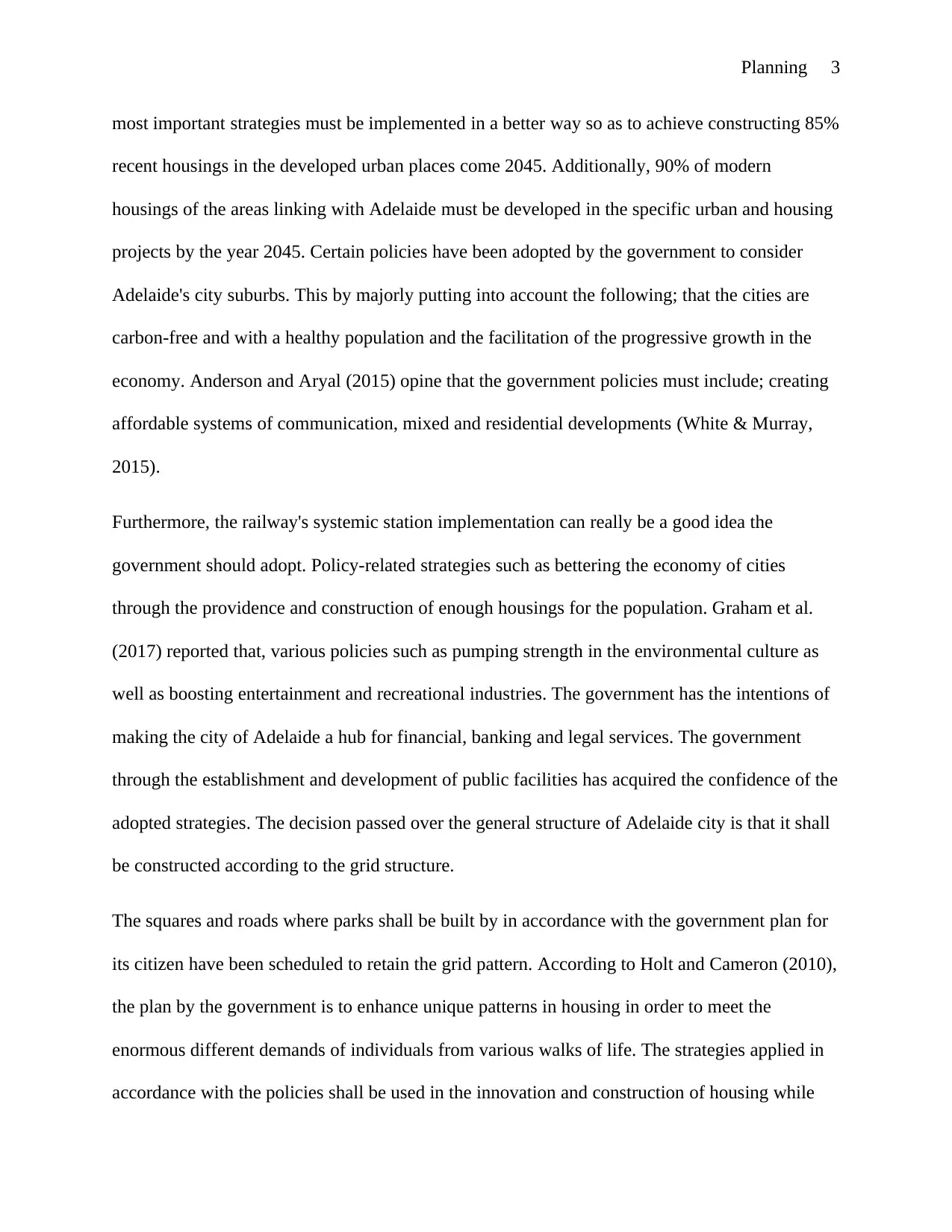
Planning 3
most important strategies must be implemented in a better way so as to achieve constructing 85%
recent housings in the developed urban places come 2045. Additionally, 90% of modern
housings of the areas linking with Adelaide must be developed in the specific urban and housing
projects by the year 2045. Certain policies have been adopted by the government to consider
Adelaide's city suburbs. This by majorly putting into account the following; that the cities are
carbon-free and with a healthy population and the facilitation of the progressive growth in the
economy. Anderson and Aryal (2015) opine that the government policies must include; creating
affordable systems of communication, mixed and residential developments (White & Murray,
2015).
Furthermore, the railway's systemic station implementation can really be a good idea the
government should adopt. Policy-related strategies such as bettering the economy of cities
through the providence and construction of enough housings for the population. Graham et al.
(2017) reported that, various policies such as pumping strength in the environmental culture as
well as boosting entertainment and recreational industries. The government has the intentions of
making the city of Adelaide a hub for financial, banking and legal services. The government
through the establishment and development of public facilities has acquired the confidence of the
adopted strategies. The decision passed over the general structure of Adelaide city is that it shall
be constructed according to the grid structure.
The squares and roads where parks shall be built by in accordance with the government plan for
its citizen have been scheduled to retain the grid pattern. According to Holt and Cameron (2010),
the plan by the government is to enhance unique patterns in housing in order to meet the
enormous different demands of individuals from various walks of life. The strategies applied in
accordance with the policies shall be used in the innovation and construction of housing while
most important strategies must be implemented in a better way so as to achieve constructing 85%
recent housings in the developed urban places come 2045. Additionally, 90% of modern
housings of the areas linking with Adelaide must be developed in the specific urban and housing
projects by the year 2045. Certain policies have been adopted by the government to consider
Adelaide's city suburbs. This by majorly putting into account the following; that the cities are
carbon-free and with a healthy population and the facilitation of the progressive growth in the
economy. Anderson and Aryal (2015) opine that the government policies must include; creating
affordable systems of communication, mixed and residential developments (White & Murray,
2015).
Furthermore, the railway's systemic station implementation can really be a good idea the
government should adopt. Policy-related strategies such as bettering the economy of cities
through the providence and construction of enough housings for the population. Graham et al.
(2017) reported that, various policies such as pumping strength in the environmental culture as
well as boosting entertainment and recreational industries. The government has the intentions of
making the city of Adelaide a hub for financial, banking and legal services. The government
through the establishment and development of public facilities has acquired the confidence of the
adopted strategies. The decision passed over the general structure of Adelaide city is that it shall
be constructed according to the grid structure.
The squares and roads where parks shall be built by in accordance with the government plan for
its citizen have been scheduled to retain the grid pattern. According to Holt and Cameron (2010),
the plan by the government is to enhance unique patterns in housing in order to meet the
enormous different demands of individuals from various walks of life. The strategies applied in
accordance with the policies shall be used in the innovation and construction of housing while

Planning 4
putting into consideration the requirements of the recent Adelaide. The government looks
forward to implementing the construction structures of building houses for the project. The other
strategy of the projection is that buildings and housings, whilst putting into account costs, shall
reflect many features of the Adelaide city (Pokalai, et al. 2016).
Specified Housing Policies
The local government is laying down policies considering the 30-Year Plan and focusing on
using the land effectively. Looking at Hepperle et al. (2018) the programs, as well as the policies
regarding the landscapes, entails protecting the primary lands that exist in the city. Protecting this
landscape should be leading towards the provision of additional land value. Hence, the
productivity increase (Lange & Norman, 2018).
The recognition and identification of the landscapes that consists of ranges of rural support and
production activity. The comments form Tomlinson and Spiller (2018) explain that in regards to
the plan, effectively utilizing the land has to begin to increase the local districts agricultural
production. These programs in the use of land are enhancing the development of the rural
villages within the locality through the improvement of living conditions. Additionally, the
policies are offering small-scale walks and browsing of tourists for the experience of the locality.
This means that apart from the rural agricultural practices, people can opt to visit the locality.
The city can, therefore, invest its time in attracting the touring people as well as offering various
good and services that suit that travellers (Lange & Norman, 2018).
There exist numerous designed sites that match various tourists' liking. This type of program
encourages the protection of the rural's open area as it adjusts the balance between land used for
produce and visualized amenity. There is an encouragement of less dense and lower scale
putting into consideration the requirements of the recent Adelaide. The government looks
forward to implementing the construction structures of building houses for the project. The other
strategy of the projection is that buildings and housings, whilst putting into account costs, shall
reflect many features of the Adelaide city (Pokalai, et al. 2016).
Specified Housing Policies
The local government is laying down policies considering the 30-Year Plan and focusing on
using the land effectively. Looking at Hepperle et al. (2018) the programs, as well as the policies
regarding the landscapes, entails protecting the primary lands that exist in the city. Protecting this
landscape should be leading towards the provision of additional land value. Hence, the
productivity increase (Lange & Norman, 2018).
The recognition and identification of the landscapes that consists of ranges of rural support and
production activity. The comments form Tomlinson and Spiller (2018) explain that in regards to
the plan, effectively utilizing the land has to begin to increase the local districts agricultural
production. These programs in the use of land are enhancing the development of the rural
villages within the locality through the improvement of living conditions. Additionally, the
policies are offering small-scale walks and browsing of tourists for the experience of the locality.
This means that apart from the rural agricultural practices, people can opt to visit the locality.
The city can, therefore, invest its time in attracting the touring people as well as offering various
good and services that suit that travellers (Lange & Norman, 2018).
There exist numerous designed sites that match various tourists' liking. This type of program
encourages the protection of the rural's open area as it adjusts the balance between land used for
produce and visualized amenity. There is an encouragement of less dense and lower scale
Paraphrase This Document
Need a fresh take? Get an instant paraphrase of this document with our AI Paraphraser
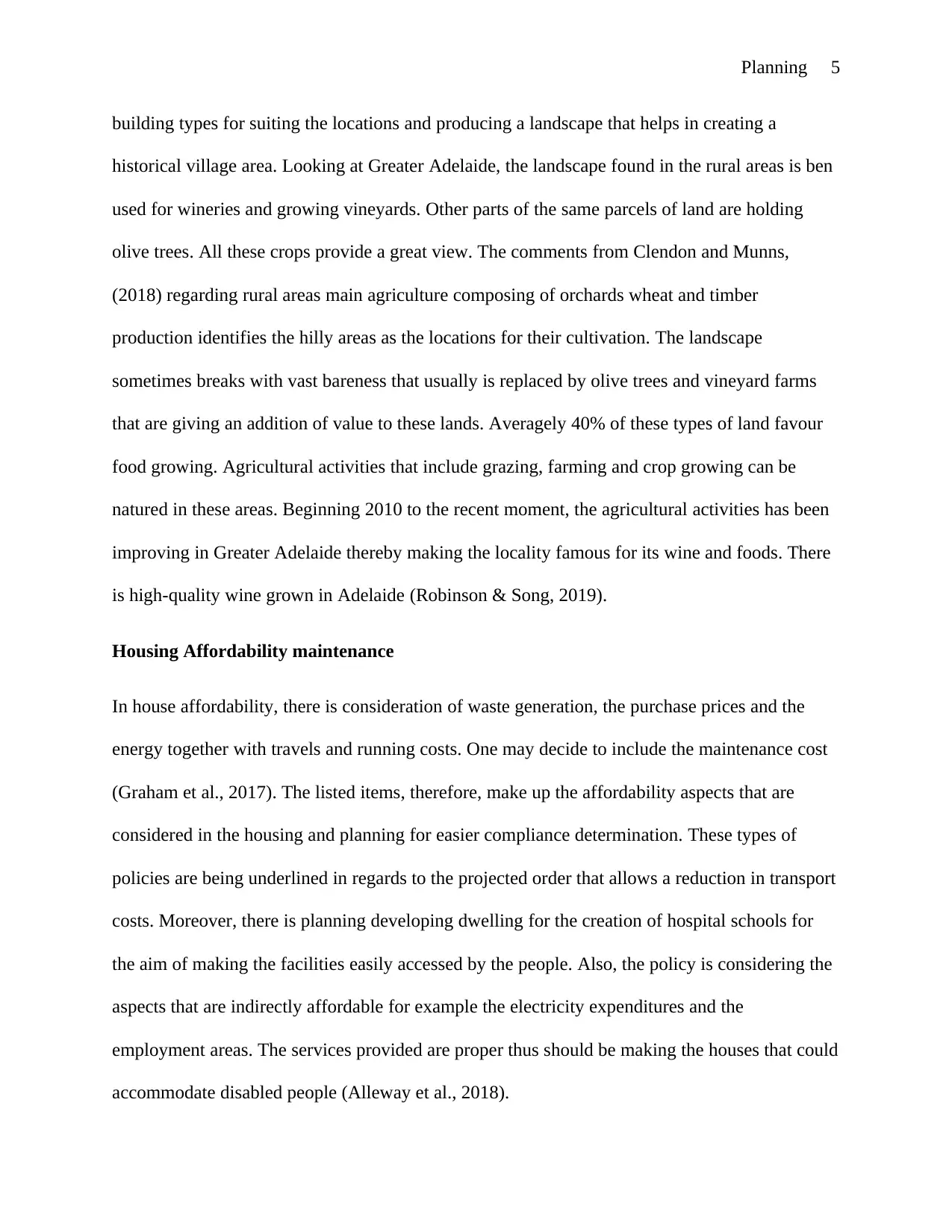
Planning 5
building types for suiting the locations and producing a landscape that helps in creating a
historical village area. Looking at Greater Adelaide, the landscape found in the rural areas is ben
used for wineries and growing vineyards. Other parts of the same parcels of land are holding
olive trees. All these crops provide a great view. The comments from Clendon and Munns,
(2018) regarding rural areas main agriculture composing of orchards wheat and timber
production identifies the hilly areas as the locations for their cultivation. The landscape
sometimes breaks with vast bareness that usually is replaced by olive trees and vineyard farms
that are giving an addition of value to these lands. Averagely 40% of these types of land favour
food growing. Agricultural activities that include grazing, farming and crop growing can be
natured in these areas. Beginning 2010 to the recent moment, the agricultural activities has been
improving in Greater Adelaide thereby making the locality famous for its wine and foods. There
is high-quality wine grown in Adelaide (Robinson & Song, 2019).
Housing Affordability maintenance
In house affordability, there is consideration of waste generation, the purchase prices and the
energy together with travels and running costs. One may decide to include the maintenance cost
(Graham et al., 2017). The listed items, therefore, make up the affordability aspects that are
considered in the housing and planning for easier compliance determination. These types of
policies are being underlined in regards to the projected order that allows a reduction in transport
costs. Moreover, there is planning developing dwelling for the creation of hospital schools for
the aim of making the facilities easily accessed by the people. Also, the policy is considering the
aspects that are indirectly affordable for example the electricity expenditures and the
employment areas. The services provided are proper thus should be making the houses that could
accommodate disabled people (Alleway et al., 2018).
building types for suiting the locations and producing a landscape that helps in creating a
historical village area. Looking at Greater Adelaide, the landscape found in the rural areas is ben
used for wineries and growing vineyards. Other parts of the same parcels of land are holding
olive trees. All these crops provide a great view. The comments from Clendon and Munns,
(2018) regarding rural areas main agriculture composing of orchards wheat and timber
production identifies the hilly areas as the locations for their cultivation. The landscape
sometimes breaks with vast bareness that usually is replaced by olive trees and vineyard farms
that are giving an addition of value to these lands. Averagely 40% of these types of land favour
food growing. Agricultural activities that include grazing, farming and crop growing can be
natured in these areas. Beginning 2010 to the recent moment, the agricultural activities has been
improving in Greater Adelaide thereby making the locality famous for its wine and foods. There
is high-quality wine grown in Adelaide (Robinson & Song, 2019).
Housing Affordability maintenance
In house affordability, there is consideration of waste generation, the purchase prices and the
energy together with travels and running costs. One may decide to include the maintenance cost
(Graham et al., 2017). The listed items, therefore, make up the affordability aspects that are
considered in the housing and planning for easier compliance determination. These types of
policies are being underlined in regards to the projected order that allows a reduction in transport
costs. Moreover, there is planning developing dwelling for the creation of hospital schools for
the aim of making the facilities easily accessed by the people. Also, the policy is considering the
aspects that are indirectly affordable for example the electricity expenditures and the
employment areas. The services provided are proper thus should be making the houses that could
accommodate disabled people (Alleway et al., 2018).
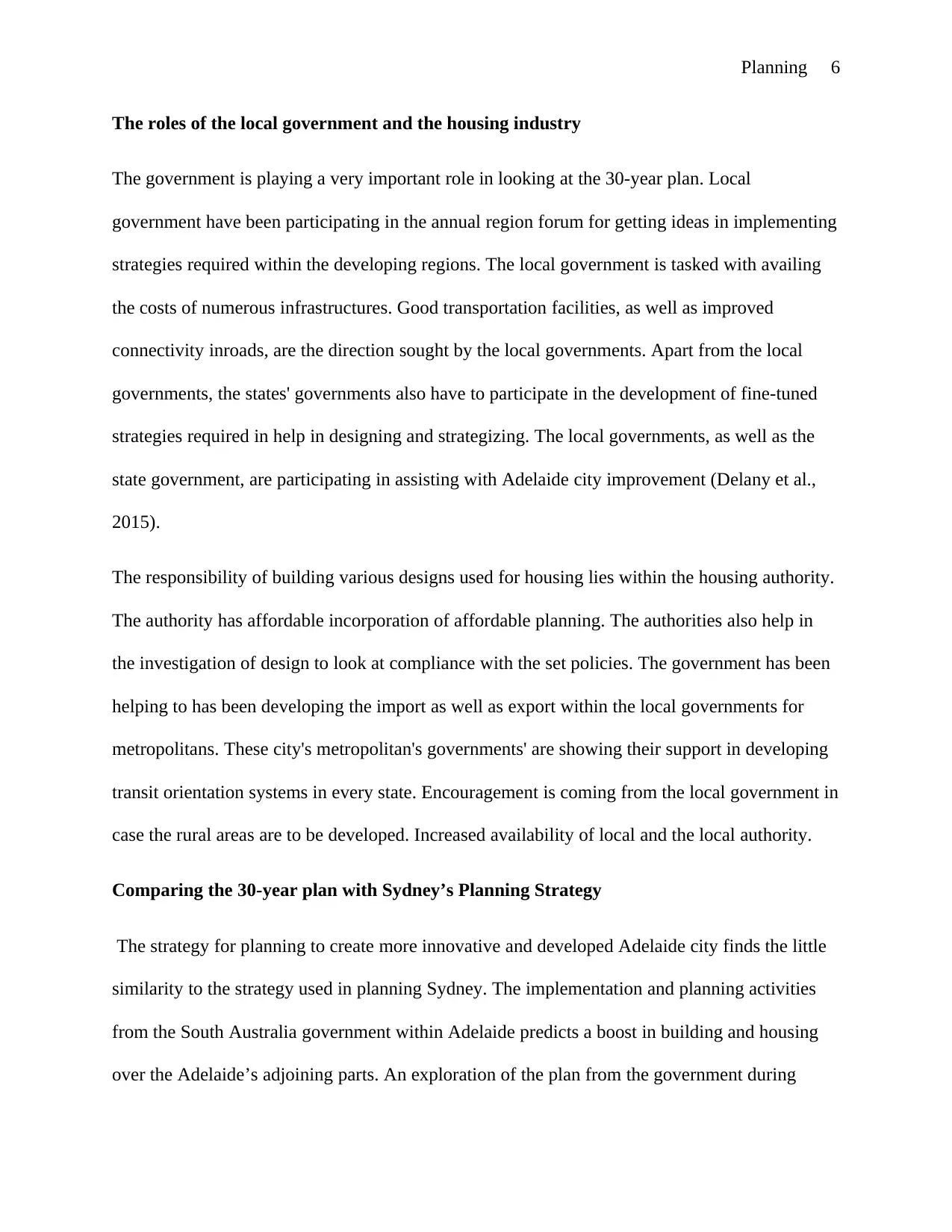
Planning 6
The roles of the local government and the housing industry
The government is playing a very important role in looking at the 30-year plan. Local
government have been participating in the annual region forum for getting ideas in implementing
strategies required within the developing regions. The local government is tasked with availing
the costs of numerous infrastructures. Good transportation facilities, as well as improved
connectivity inroads, are the direction sought by the local governments. Apart from the local
governments, the states' governments also have to participate in the development of fine-tuned
strategies required in help in designing and strategizing. The local governments, as well as the
state government, are participating in assisting with Adelaide city improvement (Delany et al.,
2015).
The responsibility of building various designs used for housing lies within the housing authority.
The authority has affordable incorporation of affordable planning. The authorities also help in
the investigation of design to look at compliance with the set policies. The government has been
helping to has been developing the import as well as export within the local governments for
metropolitans. These city's metropolitan's governments' are showing their support in developing
transit orientation systems in every state. Encouragement is coming from the local government in
case the rural areas are to be developed. Increased availability of local and the local authority.
Comparing the 30-year plan with Sydney’s Planning Strategy
The strategy for planning to create more innovative and developed Adelaide city finds the little
similarity to the strategy used in planning Sydney. The implementation and planning activities
from the South Australia government within Adelaide predicts a boost in building and housing
over the Adelaide’s adjoining parts. An exploration of the plan from the government during
The roles of the local government and the housing industry
The government is playing a very important role in looking at the 30-year plan. Local
government have been participating in the annual region forum for getting ideas in implementing
strategies required within the developing regions. The local government is tasked with availing
the costs of numerous infrastructures. Good transportation facilities, as well as improved
connectivity inroads, are the direction sought by the local governments. Apart from the local
governments, the states' governments also have to participate in the development of fine-tuned
strategies required in help in designing and strategizing. The local governments, as well as the
state government, are participating in assisting with Adelaide city improvement (Delany et al.,
2015).
The responsibility of building various designs used for housing lies within the housing authority.
The authority has affordable incorporation of affordable planning. The authorities also help in
the investigation of design to look at compliance with the set policies. The government has been
helping to has been developing the import as well as export within the local governments for
metropolitans. These city's metropolitan's governments' are showing their support in developing
transit orientation systems in every state. Encouragement is coming from the local government in
case the rural areas are to be developed. Increased availability of local and the local authority.
Comparing the 30-year plan with Sydney’s Planning Strategy
The strategy for planning to create more innovative and developed Adelaide city finds the little
similarity to the strategy used in planning Sydney. The implementation and planning activities
from the South Australia government within Adelaide predicts a boost in building and housing
over the Adelaide’s adjoining parts. An exploration of the plan from the government during
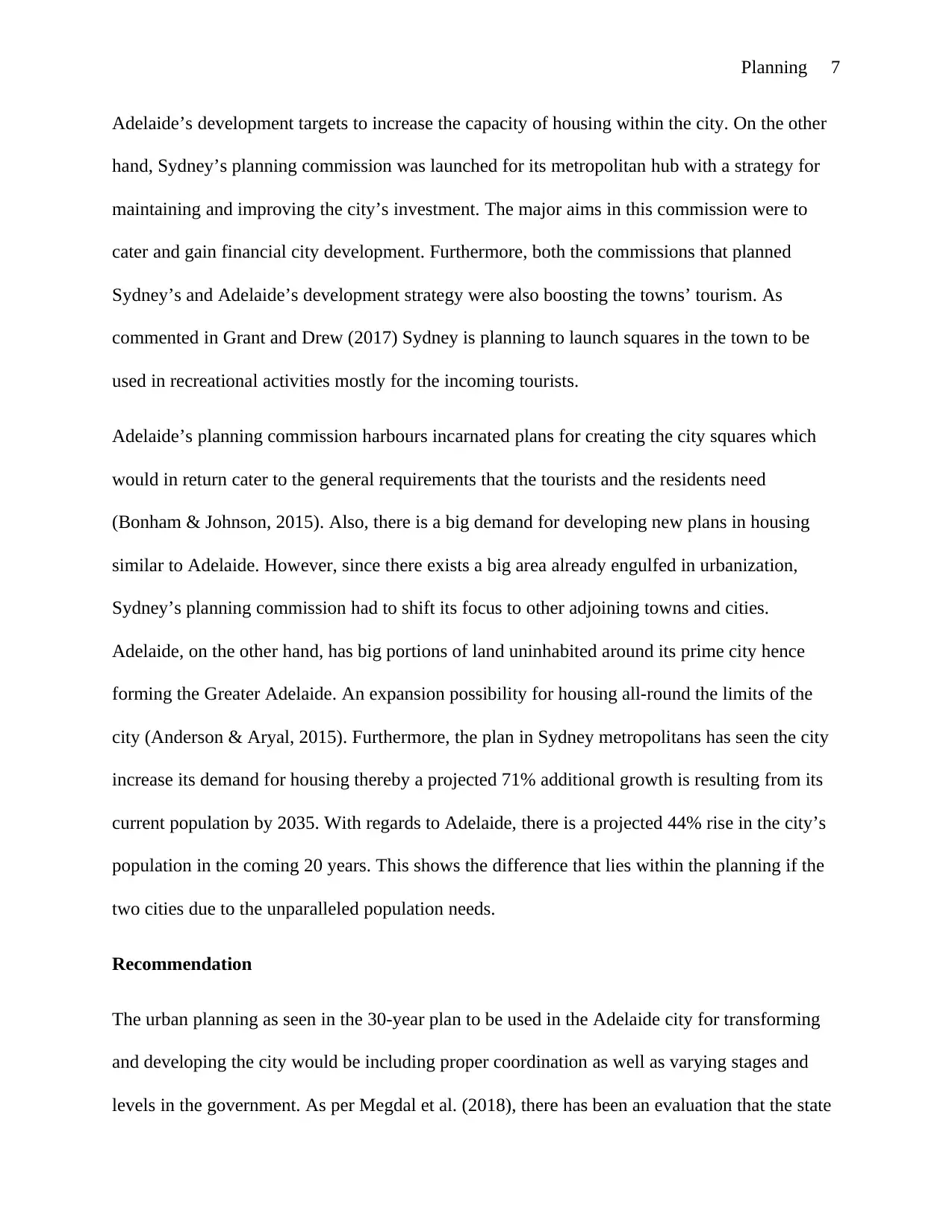
Planning 7
Adelaide’s development targets to increase the capacity of housing within the city. On the other
hand, Sydney’s planning commission was launched for its metropolitan hub with a strategy for
maintaining and improving the city’s investment. The major aims in this commission were to
cater and gain financial city development. Furthermore, both the commissions that planned
Sydney’s and Adelaide’s development strategy were also boosting the towns’ tourism. As
commented in Grant and Drew (2017) Sydney is planning to launch squares in the town to be
used in recreational activities mostly for the incoming tourists.
Adelaide’s planning commission harbours incarnated plans for creating the city squares which
would in return cater to the general requirements that the tourists and the residents need
(Bonham & Johnson, 2015). Also, there is a big demand for developing new plans in housing
similar to Adelaide. However, since there exists a big area already engulfed in urbanization,
Sydney’s planning commission had to shift its focus to other adjoining towns and cities.
Adelaide, on the other hand, has big portions of land uninhabited around its prime city hence
forming the Greater Adelaide. An expansion possibility for housing all-round the limits of the
city (Anderson & Aryal, 2015). Furthermore, the plan in Sydney metropolitans has seen the city
increase its demand for housing thereby a projected 71% additional growth is resulting from its
current population by 2035. With regards to Adelaide, there is a projected 44% rise in the city’s
population in the coming 20 years. This shows the difference that lies within the planning if the
two cities due to the unparalleled population needs.
Recommendation
The urban planning as seen in the 30-year plan to be used in the Adelaide city for transforming
and developing the city would be including proper coordination as well as varying stages and
levels in the government. As per Megdal et al. (2018), there has been an evaluation that the state
Adelaide’s development targets to increase the capacity of housing within the city. On the other
hand, Sydney’s planning commission was launched for its metropolitan hub with a strategy for
maintaining and improving the city’s investment. The major aims in this commission were to
cater and gain financial city development. Furthermore, both the commissions that planned
Sydney’s and Adelaide’s development strategy were also boosting the towns’ tourism. As
commented in Grant and Drew (2017) Sydney is planning to launch squares in the town to be
used in recreational activities mostly for the incoming tourists.
Adelaide’s planning commission harbours incarnated plans for creating the city squares which
would in return cater to the general requirements that the tourists and the residents need
(Bonham & Johnson, 2015). Also, there is a big demand for developing new plans in housing
similar to Adelaide. However, since there exists a big area already engulfed in urbanization,
Sydney’s planning commission had to shift its focus to other adjoining towns and cities.
Adelaide, on the other hand, has big portions of land uninhabited around its prime city hence
forming the Greater Adelaide. An expansion possibility for housing all-round the limits of the
city (Anderson & Aryal, 2015). Furthermore, the plan in Sydney metropolitans has seen the city
increase its demand for housing thereby a projected 71% additional growth is resulting from its
current population by 2035. With regards to Adelaide, there is a projected 44% rise in the city’s
population in the coming 20 years. This shows the difference that lies within the planning if the
two cities due to the unparalleled population needs.
Recommendation
The urban planning as seen in the 30-year plan to be used in the Adelaide city for transforming
and developing the city would be including proper coordination as well as varying stages and
levels in the government. As per Megdal et al. (2018), there has been an evaluation that the state
Secure Best Marks with AI Grader
Need help grading? Try our AI Grader for instant feedback on your assignments.
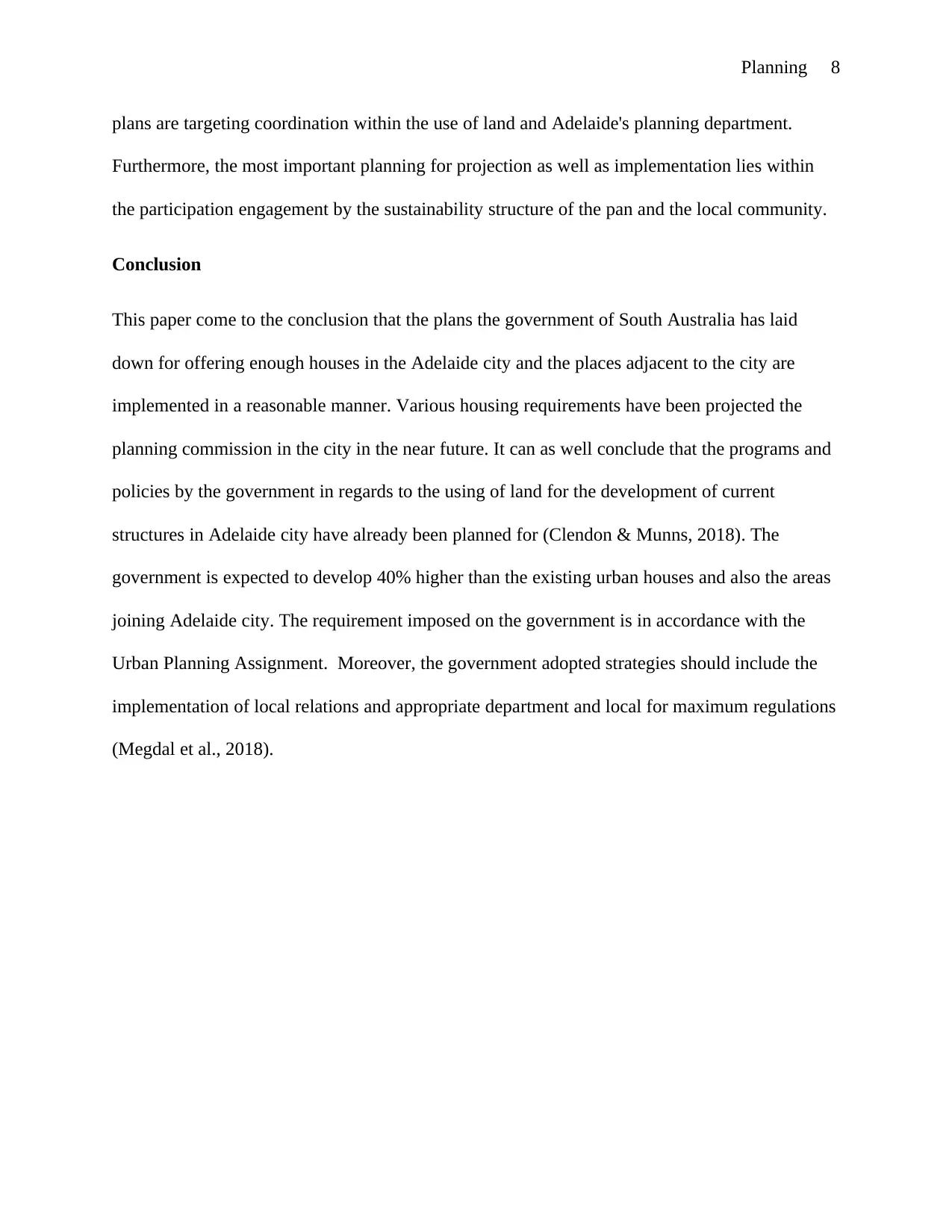
Planning 8
plans are targeting coordination within the use of land and Adelaide's planning department.
Furthermore, the most important planning for projection as well as implementation lies within
the participation engagement by the sustainability structure of the pan and the local community.
Conclusion
This paper come to the conclusion that the plans the government of South Australia has laid
down for offering enough houses in the Adelaide city and the places adjacent to the city are
implemented in a reasonable manner. Various housing requirements have been projected the
planning commission in the city in the near future. It can as well conclude that the programs and
policies by the government in regards to the using of land for the development of current
structures in Adelaide city have already been planned for (Clendon & Munns, 2018). The
government is expected to develop 40% higher than the existing urban houses and also the areas
joining Adelaide city. The requirement imposed on the government is in accordance with the
Urban Planning Assignment. Moreover, the government adopted strategies should include the
implementation of local relations and appropriate department and local for maximum regulations
(Megdal et al., 2018).
plans are targeting coordination within the use of land and Adelaide's planning department.
Furthermore, the most important planning for projection as well as implementation lies within
the participation engagement by the sustainability structure of the pan and the local community.
Conclusion
This paper come to the conclusion that the plans the government of South Australia has laid
down for offering enough houses in the Adelaide city and the places adjacent to the city are
implemented in a reasonable manner. Various housing requirements have been projected the
planning commission in the city in the near future. It can as well conclude that the programs and
policies by the government in regards to the using of land for the development of current
structures in Adelaide city have already been planned for (Clendon & Munns, 2018). The
government is expected to develop 40% higher than the existing urban houses and also the areas
joining Adelaide city. The requirement imposed on the government is in accordance with the
Urban Planning Assignment. Moreover, the government adopted strategies should include the
implementation of local relations and appropriate department and local for maximum regulations
(Megdal et al., 2018).

Planning 9
References
Alleway, H. K., Gillies, C.L., Bishop, M.J., Gentry, R.R., Theuerkauf, S.J. and Jones, R. (2018).
The Ecosystem Services of Marine Aquaculture: Valuing Benefits to People and Nature.
BioScience, 69(1), pp. 59-68.
Anderson, K. and Aryal, N. R. (2015). Growth and Cycles in Australia’s Wine Industry: A
Statistical Compendium, 1843 to 2013. 1 ed. Darwin: University of Adelaide Press.
Bonham, J. and Johnson, M. (2015). Cycling Futures. 1 ed. Perth: University of Adelaide Press.
Clendon, J. and Munns, A. (2018). Community Health and Wellness: Principles of primary
health care. 6 ed. Adelaide: Elsevier Health Sciences.
Delany, T., Lawless, A., Baum, F., Popay, J., Jones, L., McDermott, D., Harris, E., Broderick, D.
and Marmot, M. (2015). Health in All Policies in South Australia: what has supported early
implementation?. Health promotion international, 31(4), pp. 888-898.
Graham, S., Lukasiewicz, A., Dovers, S., Robin, L., McKay, J. and Schilizzi, S. (2017). Natural
Resources and Environmental Justice: Australian Perspectives. 1 ed. Melbourne: Csiro
Publishing.
Grant, B. and Drew, J. (2017). Local Government in Australia: History, Theory and Public
Policy. 1 ed. Sydney: Springer.
Hepperle, E., Paulsson, J., Maliene, V., Mansberger, R., Lisec, A. and Guelton, S. (2018).
Opportunities and Constraints of Land Management in Local and Regional Development:
Integrated Knowledge, Factors and Trade-offs. Illustrated ed. Sydney: vdf Hochschulverlag AG.
References
Alleway, H. K., Gillies, C.L., Bishop, M.J., Gentry, R.R., Theuerkauf, S.J. and Jones, R. (2018).
The Ecosystem Services of Marine Aquaculture: Valuing Benefits to People and Nature.
BioScience, 69(1), pp. 59-68.
Anderson, K. and Aryal, N. R. (2015). Growth and Cycles in Australia’s Wine Industry: A
Statistical Compendium, 1843 to 2013. 1 ed. Darwin: University of Adelaide Press.
Bonham, J. and Johnson, M. (2015). Cycling Futures. 1 ed. Perth: University of Adelaide Press.
Clendon, J. and Munns, A. (2018). Community Health and Wellness: Principles of primary
health care. 6 ed. Adelaide: Elsevier Health Sciences.
Delany, T., Lawless, A., Baum, F., Popay, J., Jones, L., McDermott, D., Harris, E., Broderick, D.
and Marmot, M. (2015). Health in All Policies in South Australia: what has supported early
implementation?. Health promotion international, 31(4), pp. 888-898.
Graham, S., Lukasiewicz, A., Dovers, S., Robin, L., McKay, J. and Schilizzi, S. (2017). Natural
Resources and Environmental Justice: Australian Perspectives. 1 ed. Melbourne: Csiro
Publishing.
Grant, B. and Drew, J. (2017). Local Government in Australia: History, Theory and Public
Policy. 1 ed. Sydney: Springer.
Hepperle, E., Paulsson, J., Maliene, V., Mansberger, R., Lisec, A. and Guelton, S. (2018).
Opportunities and Constraints of Land Management in Local and Regional Development:
Integrated Knowledge, Factors and Trade-offs. Illustrated ed. Sydney: vdf Hochschulverlag AG.
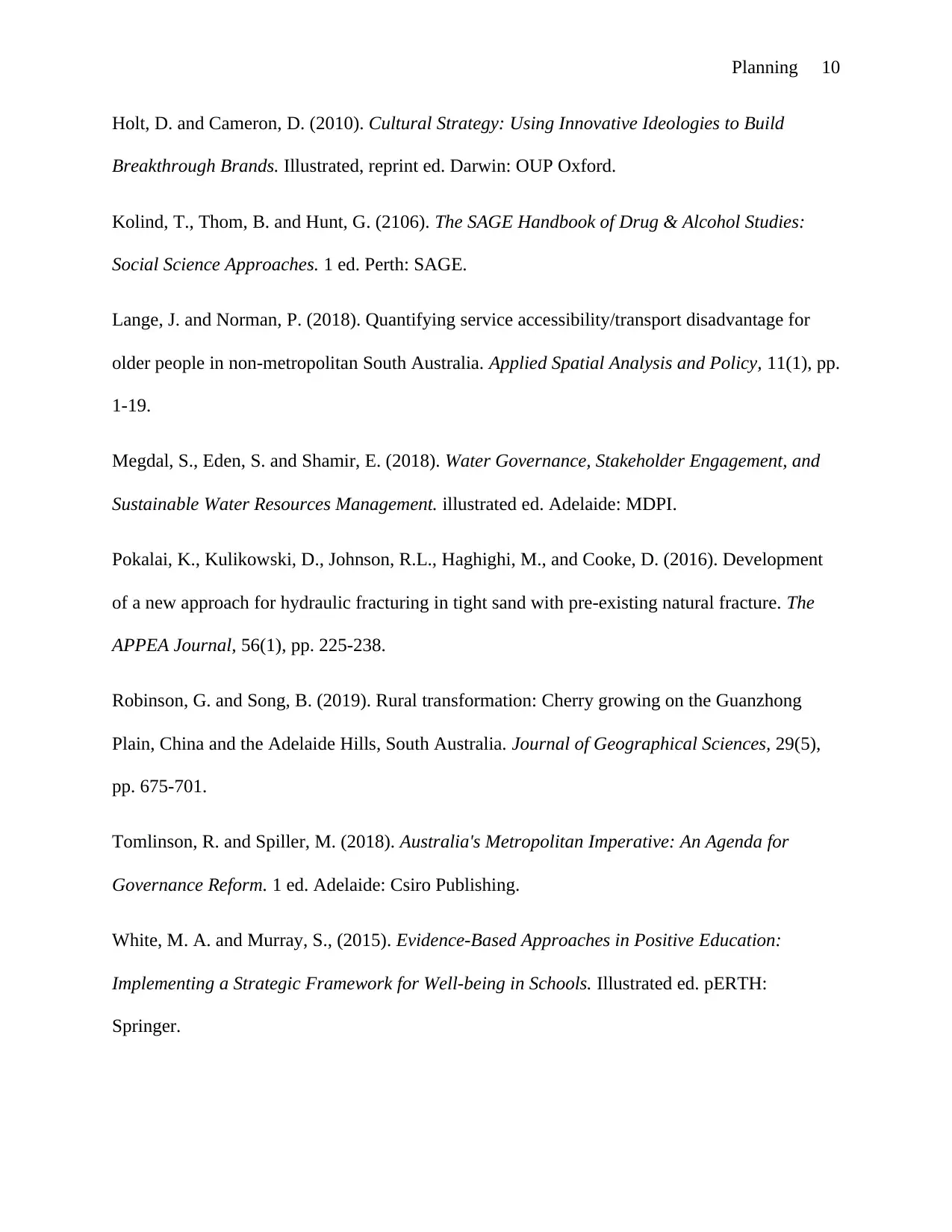
Planning 10
Holt, D. and Cameron, D. (2010). Cultural Strategy: Using Innovative Ideologies to Build
Breakthrough Brands. Illustrated, reprint ed. Darwin: OUP Oxford.
Kolind, T., Thom, B. and Hunt, G. (2106). The SAGE Handbook of Drug & Alcohol Studies:
Social Science Approaches. 1 ed. Perth: SAGE.
Lange, J. and Norman, P. (2018). Quantifying service accessibility/transport disadvantage for
older people in non-metropolitan South Australia. Applied Spatial Analysis and Policy, 11(1), pp.
1-19.
Megdal, S., Eden, S. and Shamir, E. (2018). Water Governance, Stakeholder Engagement, and
Sustainable Water Resources Management. illustrated ed. Adelaide: MDPI.
Pokalai, K., Kulikowski, D., Johnson, R.L., Haghighi, M., and Cooke, D. (2016). Development
of a new approach for hydraulic fracturing in tight sand with pre-existing natural fracture. The
APPEA Journal, 56(1), pp. 225-238.
Robinson, G. and Song, B. (2019). Rural transformation: Cherry growing on the Guanzhong
Plain, China and the Adelaide Hills, South Australia. Journal of Geographical Sciences, 29(5),
pp. 675-701.
Tomlinson, R. and Spiller, M. (2018). Australia's Metropolitan Imperative: An Agenda for
Governance Reform. 1 ed. Adelaide: Csiro Publishing.
White, M. A. and Murray, S., (2015). Evidence-Based Approaches in Positive Education:
Implementing a Strategic Framework for Well-being in Schools. Illustrated ed. pERTH:
Springer.
Holt, D. and Cameron, D. (2010). Cultural Strategy: Using Innovative Ideologies to Build
Breakthrough Brands. Illustrated, reprint ed. Darwin: OUP Oxford.
Kolind, T., Thom, B. and Hunt, G. (2106). The SAGE Handbook of Drug & Alcohol Studies:
Social Science Approaches. 1 ed. Perth: SAGE.
Lange, J. and Norman, P. (2018). Quantifying service accessibility/transport disadvantage for
older people in non-metropolitan South Australia. Applied Spatial Analysis and Policy, 11(1), pp.
1-19.
Megdal, S., Eden, S. and Shamir, E. (2018). Water Governance, Stakeholder Engagement, and
Sustainable Water Resources Management. illustrated ed. Adelaide: MDPI.
Pokalai, K., Kulikowski, D., Johnson, R.L., Haghighi, M., and Cooke, D. (2016). Development
of a new approach for hydraulic fracturing in tight sand with pre-existing natural fracture. The
APPEA Journal, 56(1), pp. 225-238.
Robinson, G. and Song, B. (2019). Rural transformation: Cherry growing on the Guanzhong
Plain, China and the Adelaide Hills, South Australia. Journal of Geographical Sciences, 29(5),
pp. 675-701.
Tomlinson, R. and Spiller, M. (2018). Australia's Metropolitan Imperative: An Agenda for
Governance Reform. 1 ed. Adelaide: Csiro Publishing.
White, M. A. and Murray, S., (2015). Evidence-Based Approaches in Positive Education:
Implementing a Strategic Framework for Well-being in Schools. Illustrated ed. pERTH:
Springer.
1 out of 10
![[object Object]](/_next/static/media/star-bottom.7253800d.svg)



